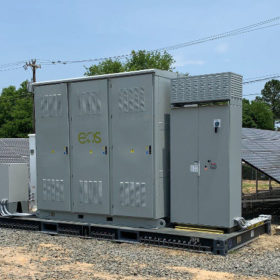
Alencon Systems has teamed up with Duke Energy to look at some of the challenges faced by utilities when adding battery storage systems to existing solar installations. DC-coupled or AC-coupled? Grounding scheme?
From pv magazine USA
Solar and battery storage make such a natural pairing that it’s becoming surprising to hear about a new utility-scale solar project that isn’t incorporating battery storage. While solar and storage are now like peanut butter and jelly, this wasn’t always true, and the United States is home to gigawatts of standalone solar projects.
But what happens when the owners of these peanut butter sandwiches decide they want jelly?
Working with Duke Energy in North Carolina, researchers at Alencon Systems studied specific issues that can arise from retrofitting existing solar structures with battery storage systems. The study specifically looked at DC-coupled storage systems, which higher-ups at Duke – like Business Development Head Tom Fenimore – believe offer compelling advantages over AC coupling.
Many recent PV projects have been subject to increasing DC:AC ratios, alongside which modern inverters have become capable of handling these DC overbuilds. With a DC-coupled battery system, any generation that exceeds the power rating of the inverter can be immediately diverted into a battery during periods of overproduction. With an AC-coupled battery, this isn’t possible and the generation is lost.
For a utility that is reliant upon being able to dispatch electricity quickly and predictably, this is a much more appealing scenario. It also helps that any storage project looking to get investment tax credit incentives must be charged directly from the PV. This is something that Fenimore identified to Alencon as being a serious consideration Duke makes in battery projects. Why make a project more expensive if you don’t have to?
Installation issues
Deciding on DC-sided storage, however, is not the end of installation complications. Something Alencon found to be a common issue for Duke was the need to isolate the grounding of the PV system from its new battery. PV projects connected to inverters are all typically grounded. usually they are grounded negatively, but some older projects, including some included in the study, are positively grounded.
Regardless of grounding polarity, battery energy storage systems need to have floating grounds as a critical safety component. This is where galvanic isolation is utilized. Galvanic isolation is useful in solar projects where electric circuits must communicate, but their grounds are at different potentials.
The study relied partially on Duke’s McAlpine Solar plant battery retrofit in 2019 for the real-world application of the retrofit issues and solutions presented. This installation feature positively grounded PV panels, which meant the installation had to feature a galvanically isolated DC-DC converter.
Lắp đặt điện mặt trời Khải Minh Tech
https://ift.tt/2X7bF6x
0906633505
info.khaiminhtech@gmail.com
80/39 Trần Quang Diệu, Phường 14, Quận 3
Lắp đặt điện mặt trời Khải Minh Tech
https://ift.tt/2ZH4TRU
Không có nhận xét nào:
Đăng nhận xét